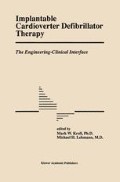Abstract
FOR DEFIBRILLATION energy, at least a 10 J safety margin between the estimate of the defibrillation threshold for a patient and the programmed shock energy is a widely accepted requirement for proper ICD function. Safety margins for sensing and for rate detection are also critical requirements but they are not as widely considered and evaluated during implant testing and followup. Sensing of an event occurs at the instant in time when the processed electrogram signal exceeds a reference threshold. Detection classifies each sensed event and analyzes the recent series of events with algorithms to initiate therapy. A sensing safety margin is needed to compensate for variability in electrogram amplitudes, whereas a detection safety margin is required to compensate for cycle length variability during an episode or between episodes. This chapter describes these sensing and detection safety margins; offers practical methods for their estimation; and discusses implications for programming ICD sensing and detection parameters.
Access this chapter
Tax calculation will be finalised at checkout
Purchases are for personal use only
Preview
Unable to display preview. Download preview PDF.
References
Olson WH: Tachyarrhythmia sensing and detection. In: Implantable Cardioverter-Defibrillator, I Singer (ed). Armonk, NY: Futura Publishing Co., Inc. 1994, Chapter 4, pp 71–107.
Olson WH, Gunderson BD, Fang-Yen MC, et al. Properties and performance of rate detection algorithms for three implantable cardioverter-defibrillators. Computers in Cardiology 1994. IEEE Computer Society Press, 1995:65–68.
Mann DE, Kelly PA, Damle RS, et al. Undersensing during ventricular tachyarrhythmias in a third-generation implantable cardioverter defibrillator. PACE 1994;17:1525–1530.
Bardy GH, Ivey TD, Stewart R, et al. Failure of the automatic cardioverter defibrillator to detect ventricular fibrillation. Am J Cardiol 1986;58:1107–1108.
Callans DJ, Hook BG, Marchlinski FE. Effect of rate and coupling interval on endocardial R-wave amplitude in permanent ventricular sensing lead systems. J Am Coll Cardiol 1993;22:746–750.
Callans DJ, Hook BG, Kleiman RB, et al. Unique sensing errors in third-generation implantable cardioverter-defibrillators. J Am Coll Cardiol 1993;22:1135–1140.
Ellenbogen KA, Wood MA, Stambler BS, et al. Measurement of ventricular electrogram amplitude during intraoperative induction of ventricular tachyarrhythmias. Am J Cardiol 1992;70:1017–1022.
Leitch JW, Yee R, Klein GJ, et al. Correlation between the ventricular electrogram amplitude in sinus rhythm and in ventricular fibrillation. PACE 1990;13:1105–1109.
Perry GY, Kosar Em. Problems in managing patients with long QT syndrome and implantable cardioverter defibrillators: a report of two cases. PACE 1996;19:863–867.
Frazier DW, Stanton MS. Pseudo-oversensing of the T-wave by an implantable cardioverter defibrillator: a nonclinical problem. PACE 1994;17:1311–1315.
Kelly PA, Mann DE, Damle RS, et al. Oversensing during ventricular pacing in patients with a third-generation implantable cardioverter-defibrillator. J An Coll Cardiol 1994;23:1531–1534.
Rosenthal ME, Paskman C. Noise generation during bradycardia pacing with the Ventritex Cadence/CPI Endotak ICD system: incidence and clinical significance. PACE 1996;19:677. (abstract)
Man KC, Davidson T, Langberg JJ, et al. Interference from a hand held radiofre-quency remote control causing discharge of an implantable defibrillator. PACE 1993;16:1756–1758. (also letter: PACE 1994 17:685)
Mathew P, Lewis C, Neglia J, et al. Interaction between electronic surveillance systems and implantable defibrillators: insights from a fourth generation ICD. Submitted to PACE.
Sandler MJ, Kutalek SP. Inappropriate discharge by an implantable cardioverter defibrillator: recognition oyopotential sensing using telemetered intracardiac electrograms. PACE 1994;17:665–671.
Almeida HF, Buckingham TA. Inappropriate implantable cardioverter defibrillator shocks secondary to sensing lead failure: utility of stored electrograms. PACE 1993;16:407–411.
Epstein AE, Shepard RB. Failure of one conductor in a nonthoracotomy implantable defibrillator lead causing inappropriate sensing and potentially ineffective shock delivery. PACE 1993;16:796–800.
Daoud EG, Kirsh MM, Boiling SF, et al. Incidence, presentation, diagnosis, and management of malfunctioning implantable cardioverter-defibrillator rate-sensing leads. Am Heart J 1994;128:892–895.
Olson WH, Peterson DK, Ruetz LL, et al. Discrimination of fast ventricular tachycardia from ventricular fibrillation and slow ventricular tachycardia for an implantable pacer-cardioverter-defibrillator. Computers in Cardiology 1993. IEEE Computer Society Press, 1993:835–838.
Swerdlow CD, Chen PS, Kass RM, et al. Discrimination of ventricular tachycardia from sinus tachycardia and atrial fibrillation in a tiered-therapy cardioverter-defibrillator. J Am Coll Cardiol 1994;23:1342–1355.
Geibel A, Zehender M, Brugada P, et al. Changes in cycle length at the onset of sustained tachyarrhythmias — importance for antitachycardia pacing. Am Heart J 1988;115:588–592.
Volosin KJ, Beauregard LM, Fabiszewski R, et al. Spontaneous changes in ventricular tachycardia cycle length. J Am Coll Cardiol 1991;17:409–414.
Olson WH, Bardy GH: Cycle length and morphology patterns at onset of spontaneous ventricular tachycardia and fibrillation. PACE 1986;9:284. (abstract)
Langer A, Heilman MS, Mower MM, et al. Considerations in the development of the automatic implantable defibrillator. Med Instrum 1976;10:163–167.
Routh AG, Larnard DJ. The probability density function as an arrhythmia discriminator in cardiac electrogram analysis. Miami Technicon International Conference, 1987;IEE TH0206:19–22.
Gillberg JM, Olson WH, Bardy GH, et al. Electrogram width algorithm for discrimination of supraventricular rhythm from ventricular tachycardia. PACE 1994;17:866. (abstract)
Maloney J, Masterson M, Khoury D, et al. Clinical performance of the implantable cardioverter defibrillator: electrocardiographic documentation or 101 spontaneous discharges. PACE 1991;14:280–285.
Swerdlow CD, Ahern T, Chen PS, et al. Underdetection of ventricular tachycardia by algorithms to enhance specificity in a tiered-therapy cardioverterdefibrillator. J Am Coll Cardiol 1994;24:416–424.
Jung W, Manz M, Moosdorf R, et al. Failure of an implantable cardioverter-defibrillator to redetect ventricular fibrillation in patients with a nonthoraco-tomy lead system. Circulation 1992;86:1217–1222.
Editor information
Editors and Affiliations
Rights and permissions
Copyright information
© 1996 Springer Science+Business Media New York
About this chapter
Cite this chapter
Olson, W. (1996). Safety Margins for Sensing and Detection: Programming Tradeoffs. In: Kroll, M.W., Lehmann, M.H. (eds) Implantable Cardioverter Defibrillator Therapy: The Engineering-Clinical Interface. Developments in Cardiovascular Medicine, vol 188. Springer, Boston, MA. https://doi.org/10.1007/978-1-4615-6345-7_19
Download citation
DOI: https://doi.org/10.1007/978-1-4615-6345-7_19
Publisher Name: Springer, Boston, MA
Print ISBN: 978-1-4613-7914-0
Online ISBN: 978-1-4615-6345-7
eBook Packages: Springer Book Archive

